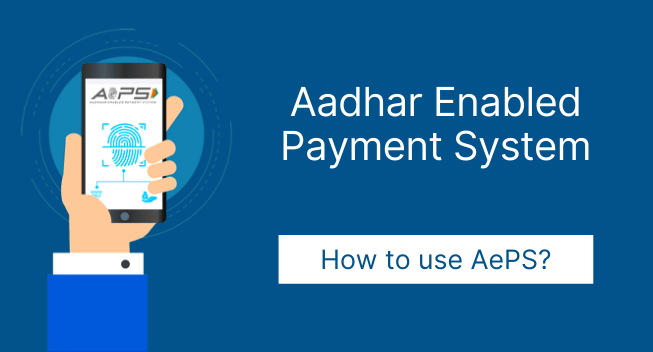Aadhar enabled payment system (AePS) is a system used to carry out your financial transactions more securely with the help of Micro- ATMs and with an Aadhar number which will be verified by Iris or fingerprint scan. This system is developed by the National Payments Corporation of India.
In this system, the person whether a sender or receiver, doesn’t need their account number for financial transactions from their accounts. This can now be done with the help of an Aadhar card. The process of the account number and IFSC code is very time-consuming and sometimes the errors can also occur which can lead to money loss. To overcome this National Payments Corporation of India developed the Aadhar Enabled Payment System. This will also increase the layers of security in online transactions and no need to care for big number series of account number and IFSC code.

How to use AePS?
Follow the simple steps-
- Visit a bank correspondent in your area (if you don’t have an account in that area’s bank then you can use the AePS with this bank also.)
- Enter the Aadhar number in the Pos machine.
- Select the transaction type- money transfer, cash deposit, withdrawal, mini statement, balance enquiry, E-KYC, etc.
- Select the name of the bank.
- Enter the amount
- Verify it by your biometrics (fingerprint or iris scan).
- The transaction will be completed in a couple of seconds.
- A confirmation receipt will be given to you.
Documents Required for AePS Transactions
- Aadhar Number
- IIN of costumer’s bank
- The fingerprint of the account holder carrying out the payment
Benefits of AePS
- Banking and non-banking transactions can be performed through banking correspondent.
- One bank correspondent can perform transactions with other banks.
- People do not need Debit/credit cards to do transactions anymore.
- It adds security by asking for the fingerprint scan before payment.
- The machines are capable of carrying to distant places, as a result, people in remote areas can carry out financial transactions online.
Features of Aadhar Enabled Payment System (AePS)
The main features of AePS are:
- It is easy to use and transactions are safe.
- Users can interoperate it across various banks.
- It encourages financial inclusions and also serves the part of the country which do not have access to banks.
- Aadhar Enabled Payment System (AePS) enables the bank account holders to access their respective bank accounts through Aadhar Authentication.
- AePS helps in the disbursement of the Government schemes such as NREGA, Social Security Pension Scheme, Handicap Pension scheme or Old age Pension Scheme, etc.
Facilities People Can Get with AePS
- Cash deposit and Withdrawal
- Balance inquiry
- Money transfer
- Mini statement
- E-KYC
- Payment Transactions (C2B, C2G Transactions)
- Aadhar to Aadhar funds transfer
Important Points You Should Remember
- Your bank account should be linked with your Aadhar card.
- If you have more than one bank account in a single bank then the primary one will be used for the Aadhar enabled payment system.
- No OTP or PIN is required in the case of an AePS transaction.
- AePS can only do transactions if both the bank accounts are linked with Aadhar.
Charges for Aadhar enabled payment system
- UIDAI charges a minimal transaction fee.
- NPCI charges up to 25 paise for settlement.
- Bank may charge 1% on every single transaction. The approx. transaction charges are INR 5 to INR 15.
AePS Fund Transfer Limit
The RBI doesn’t issue any official payment limit for the AePS fund transfer but certain banks have set up a limit as a precaution to the money misuse. The limit set by some banks is Rs. 50,000.
Reason behind the AePS
Under the scheme “cashless India”, the government of India has a target to bring all the citizens of the country under the banking framework. But, it is not possible or very hardly possible to set up banks in rural and remote areas of the country. So, the government came up with Aadhar enabled payment system so that people of the remote areas can receive or send money or do any financial transactions with the help of micro ATMs or bank correspondents present in their areas.
This idea also makes the payment system more secure than before because of the Iris and fingerprint scan system. It also had reduced the burden on people to carry or give someone their account details for the transactions.
Members in AePS Steering Committee
| Sr. No. | Bank Name |
| 1. | Axis Bank |
| 2. | Bank of Baroda |
| 3. | Bank of India |
| 4. | Bank of Maharashtra |
| 5. | Central Bank |
| 6. | Central Bank of India |
| 7. | Fino Payments Bank |
| 8. | ICICI Bank |
| 9. | IDFC Bank |
| 10. | IndusInd Bank |
| 11. | Punjab National Bank |
| 12. | RBL Bank |
| 13. | Saraswat Co-operative Bank Ltd. |
| 14. | State Bank of India |
| 15. | UCO Bank |
| 16. | Union Bank of India |
| 17. | Yes Bank |
| 18. | Indian’s Bank Association |
| 19. | UIDAI |
| 20. | Business Correspondent Federation of India |
| 21. | Paynearby |
| 22. | Fingpay |
Frequently Asked Questions
Q1. Who can use this Aadhar enabled payment system?
Ans. All Indian citizens with an Aadhar card and a bank account can opt for this.
Q2. Is it possible to link more than one bank account with a single Aadhar card?
Ans. Yes, it is possible to link more than one bank account with a single Aadhar card.
Q3. What type of account is needed for the Aadhar enabled payment system payment service?
Ans. You can opt for Aadhar enabled payment system with any type of bank account.
Q4. How many banks are under Aadhar enabled payment system currently?
Ans. Currently, there are 118 banks under AePS.
Q5. What is E-KYC?
Ans. E-KYC means the KYC of a customer in electronic form with the help of an Aadhar card.
Q6. What are ON-US payments?
Ans. When the payments are made within the same bank then it is known as ON-US payments.
Q7. What are OFF-US transactions?
Ans. When the payments are made between two different banks then it is known as an OFF-US transaction. E.g. from the State bank of India to Punjab national bank.
Q8. Who is the acquirer bank?
Ans. The Bank acquiring the transaction is called as acquirer bank.
Q9. What is RRN?
Ans. RRN is a 12 digit number given to each transaction to identify each and every transaction separately.
Q10. Is Aadhar enabled payment system safe?
Ans. Aadhar enabled payment system is developed by the national payments corporation of India. It is secure as well as safe to use.


